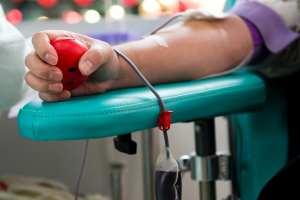The Australian Red Cross Service recently put an emergency call out for donors of O negative blood. Due to an overwhelming flu season regular donations slowed.
Posting a call out on their Facebook page they said, “We haven’t needed you this much in 5 years! Cold and flu season has hit us hard this year with many of our regular donors unable to donate. We need another 3,000 O negative donors around the country in the next two weeks to meet patient demand”.
Our blood supply levels rely heavily on regular, voluntary and unpaid donors. While many may want to donate, understanding the process of donating, how donations are used and eligibility criteria is essential to boosting donor numbers.
How are blood donations used?
Blood is extremely versatile and, according to the Australian Red Cross Blood Service, each donation can be utilised in 22 different medical procedures.
Blood donations in Australia are utilised in the following ways:
- 24% goes to cancer and blood disease patients
- 19% goes to helping those with other causes of anaemia
- 18% goes towards surgical patients
- 13% goes to other medical problems including heart, stomach and kidney diseases
- 10% goes to orthopaedic patients
- 4% goes to obstetrics
- 2% goes to trauma and road accidents
Are you eligible to give blood? We look at the facts and everything you need to know surrounding blood donation.
Types of blood donation
Blood is made up of several different components that can be utilised in donations. You can donate whole blood, plasma and platelets.
- Whole blood donations are collected straight from a donor. These can be separated in a laboratory into red blood cells, plasma and platelets.
- Plasma donations can be used for a range of conditions including cancer, blood diseases, haemophilia, anaemia, trauma and more.
- Platelet donations take 15 minutes to collect but the appointment itself takes up to 45 minutes. This is a more intense donation than whole blood and you can only donate platelets every 12 weeks.
Australia needs over 25,000 blood donations per week, and if just one person decides to give blood it can save three lives, so what can you do to help?
Who can donate?
Most Australians aged 16 – 70 years old are eligible to give blood, however, there are some situations in which you may not be eligible to donate. You cannot give blood if you have a cold or flu, had an upset stomach in the past week or have been to the dentist recently.
In order for you to give blood and ensure that it is safe, there are some conditions and circumstances that may make some people ineligible to donate either temporarily or permanently. These include:
- Restrictions may apply if you have travelled overseas recently
- Have Lupus
- If you have low iron levels
- Have angina
- Are pregnant or breastfeeding
- Have or have had Hepatitis C
- Are currently battling cancer
- Have or have had leukaemia or lymphoma
- Suffer from chronic fatigue syndrome
- If you have Multiple sclerosis
- HIV or AIDS (If currently have it or have had it in the past)
The Australian Red Cross Blood Services website has a short quiz available to test whether you are eligible to give blood.
Different blood types
Blood types help determine what kind of blood you can accept and what other blood types you can donate to. There are eight main blood types which are inherited from a mix of your parents’ genetics. These are A, B, AB or O which can be either Rhesus type negative or positive.
- AB: Blood type AB is the rarest. but fortunately the plasma of AB blood types (positive or negative) can be donated to any patient regardless of their blood type.
- A: 38% of the population are type A blood. This is always required for whole blood, plasma and platelet donations.
- B: 10% of the Australian population have type B blood. Plasma donations are required from this blood group to assist with trauma victims, severe burns or those with blood diseases.
- O: O- is another rare blood type with only 9% of the population having this type. Anyone with this blood type can donate to any patient. This makes a huge difference in the lives of many. O+ is the most common blood type and whole blood, plasma or platelets can be donated.
How does it work?
The process of donating blood generally takes an hour. It involves an interview, the collection of blood, plasma or platelets and some time to relax and enjoy refreshment afterwards.
For more information on what it is like to donate blood you can read one of our previous blog posts here.





